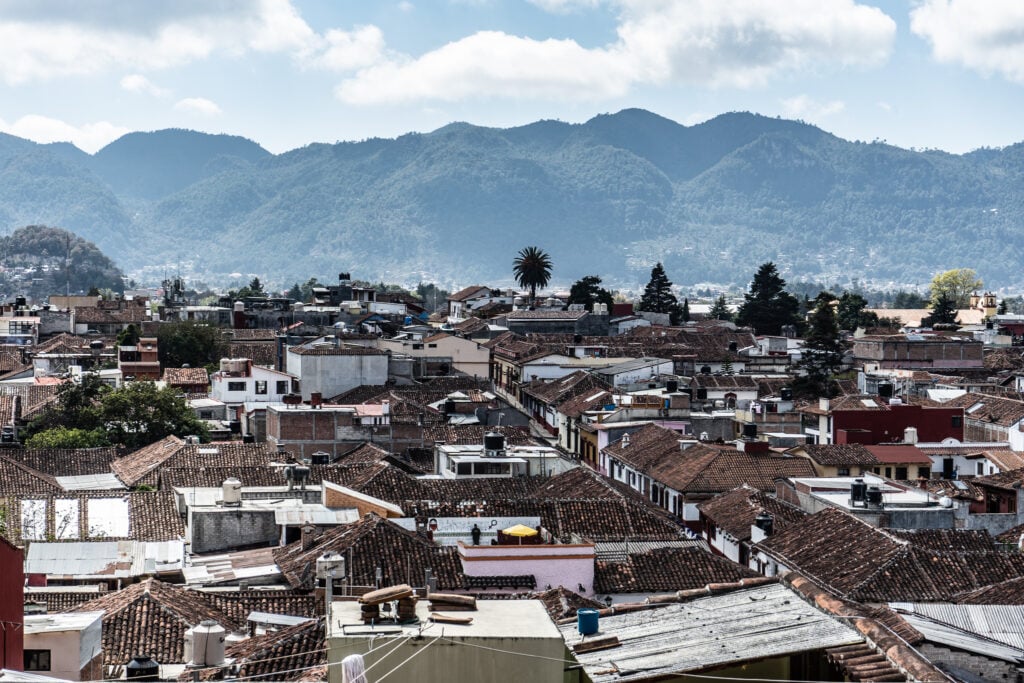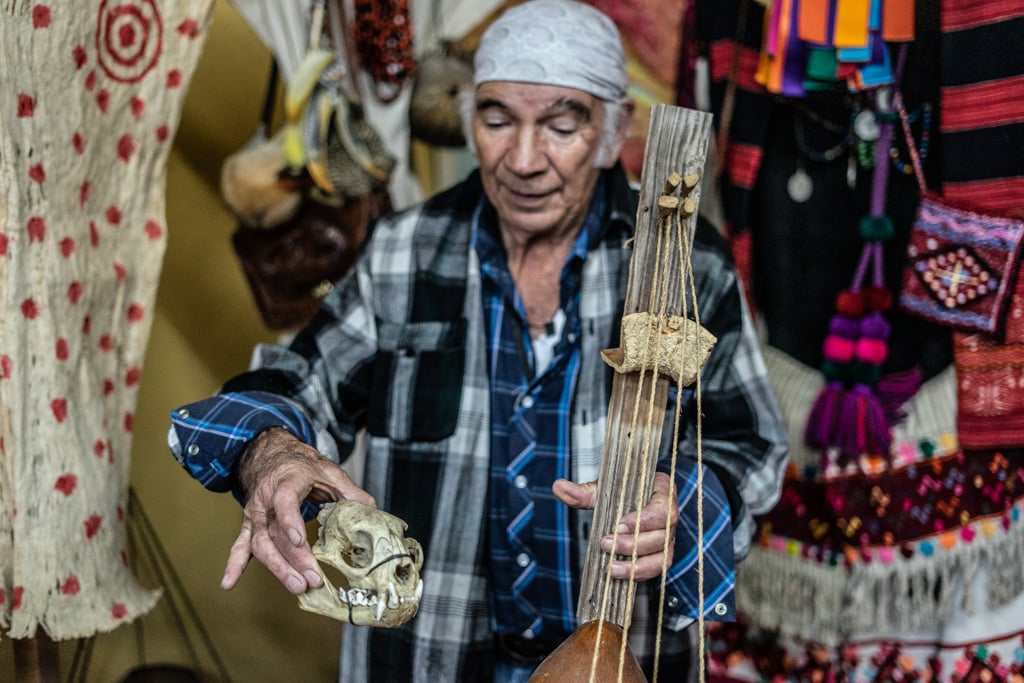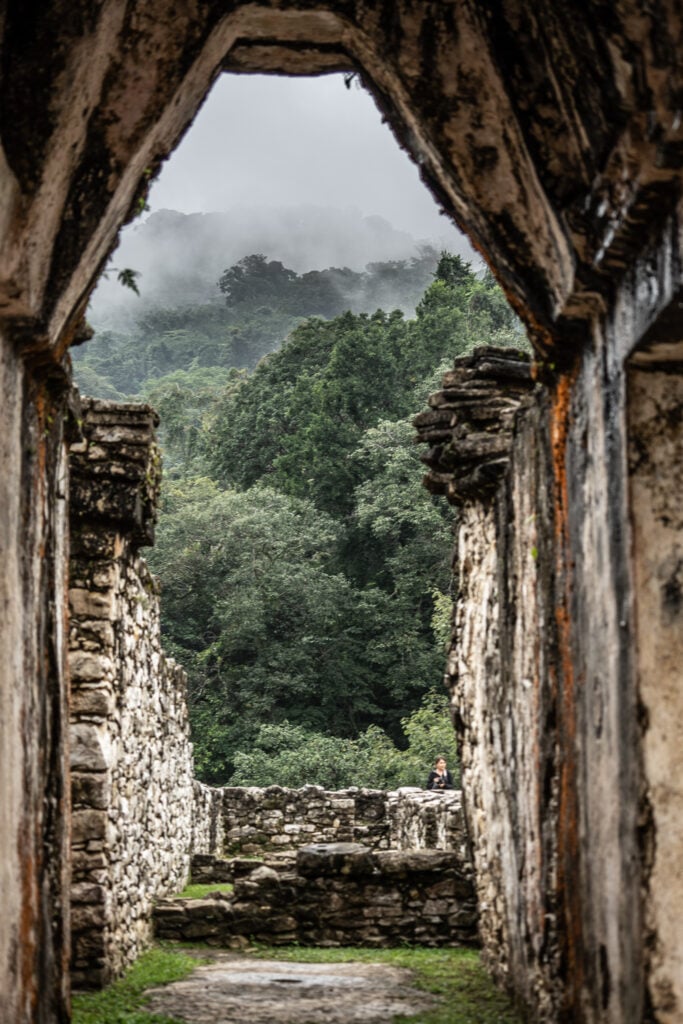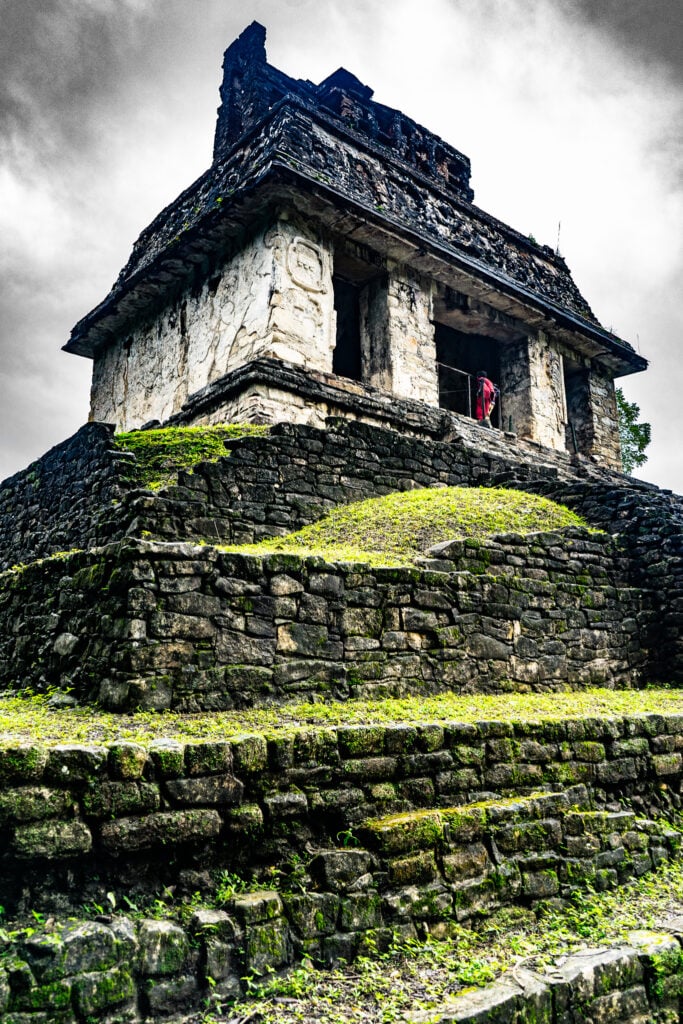From the curious ceremonies of San Juan Chamula to the rocky cliffs of the Sumidero Canyon, here are the best things to do in Chiapas, Mexico!
Mexico’s southernmost state is an amalgamation of cultures, religions and languages the likes of which are difficult to find elsewhere in the country. The Conquistadors may have founded San Cristobal de las Casas, the most famous city in Chiapas, in the early 16th century, but they never truly conquered the Lacandon jungles or the Chiapan highlands.
Indigenous languages like Tzotzil and Ch’ol still reign supreme in Chiapas, while villages like San Juan de Chamula have merged Catholic practices with local customs to create a powerful fusion of religious ceremonies.
At times, though, Chiapas feels like a tinderbox waiting to spark. This might be Mexico’s most culturally rich state, but economically, it’s the poorest, and the left-wing guerillas of the Zapatistas (who launched a coup in 1994) still fight (now peacefully) for increased indigenous rights and protections.
For the adventurous traveller, Chiapas is the Mexican destination you’ve been looking for. There are no all-inclusive resorts here, and instead, you’ll be given a raw introduction to the ‘real Mexico’. There are no cartels, either, and instead of white sand beaches, you’ve got stunning canyons, crashing waterfalls, and some of the most mysterious Maya ruins in Mexico to discover.
If you’re looking to explore a lesser-visited part of Mexico, then keep reading, as we list the best things to do in Chiapas!
Table of Contents
The best things to do in Chiapas
Explore the Sumidero Canyon, visit San Cristobal de las Casas, and uncover the ruins of Palenque; here are the best things to do, and the best places to visit, in Chiapas.
1. Explore the cobbled streets of San Cristobal de las Casas
San Cristobal de las Casas, hidden away in the highlands of Chiapas, Mexico, is known for its indigenous culture and colonial architecture.
As you stroll through the cobbled streets, you’re met with an array of colourful buildings, punctuated by historic churches like the yellow Santo Domingo Church, which is also home to a quirky artisan market selling handmade crafts.
The city’s culinary scene serves a mixture of Mexican and international cuisine, alongside the locally grown, globally celebrated Chiapanecan coffee.
The Municipal Market and the Maya Textile Center offer immersive experiences of the region’s indigenous heritage, and nearby, natural attractions like the Sumidero Canyon and indigenous communities, such as San Juan Chamula, invite exploration with San Cristobal de las Casas as your base. Just watch out for the city’s surprisingly high altitude!

Read more: 21 Best Things to Do in San Cristobal de las Casas, Mexico
2. Visit the ‘Medicine Man of Chiapas’
A visit to the ‘Medicine Man of Chiapas’ was one of the best things I did during my stay in the state. The man in question is Sergio Castro, a veterinarian turned humanitarian who operates a free clinic for indigenous people in San Cristobal de las Casas.
The ‘House of Sergio Castro‘ is a remarkable cultural and humanitarian landmark. Sergio Castro, often known as the ‘Saint of Chiapas’, is a tireless local hero, recognised for treating burns and wounds, especially among those who can’t afford health care.
His house, which doubles as a museum, showcases a rich collection of traditional costumes and artifacts from Chiapas’ diverse indigenous groups. Visitors have the chance to learn about the state’s distinct cultures, while their donations help fund Sergio’s medical work.

Read more: The Medicine Man of Chiapas
3. See the curious religious ceremonies in San Juan Chamula
San Juan Chamula, often simply referred to as Chamula, is an intriguing indigenous town in the highlands of Chiapas, Mexico.
It’s primarily inhabited by the Tzotzil Maya people who maintain a unique blend of Catholicism and indigenous religious practices. The town’s most notable feature is its church, the Iglesia de San Juan, known for its unconventional rituals that incorporate ancient Mayan practices.
Inside, you’ll find a floor covered in pine needles, numerous candles and locals engaging in prayer and healing ceremonies while letting off fireworks and occasionally beheading an unfortunate chicken.
A visit to Chamula offers a deep insight into the complex blend of cultures that characterises Chiapas; just be prepared for lots of loud noises, explosions and a bit of bloodletting.
I visited Chamula on an excellent day trip from San Cristobal de las Casas, guided by the excellent team at Alex y Raul Tours.

Read more: How Many States in Mexico? Everything You Need to Know.
4. Meet the weavers of Zinacantan
Zinacantán, located a short drive from San Cristobal de las Casas, is a traditional indigenous village renowned for its weaving traditions.
Inhabited by the Tzotzil Maya people, Zinacantán offers visitors a glimpse into their rich heritage, and in particular, their colourful textile craftsmanship and spiritual practices.
The village is known for its distinctive embroidered textiles, woven garments, and intricate weaving techniques. Exploring Zinacantán allows you to witness the weaving in practice, as many of the locals are happy to demonstrate their talents to visitors. You may even be asked to participate in the weaving itself!
The unique cultural immersion, combined with the stunning natural surroundings of the Chiapas highlands, makes Zinacantán an unforgettable destination for those seeking to learn more about the region’s indigenous culture.
I visited as part of a combined trip to San Juan Chamula. Most day tours include a stop in both villages, as they’re not too far from one another.

Read more: Is Mexico a Country? Everything You Need to Know.
5. Learn all about the Zapatistas (Viva la Revolucion!)
Visiting the Zapatista communities in Chiapas offers a unique insight into a revolutionary society built on indigenous rights, autonomy, and resistance to globalization.
The Zapatistas, formally known as the Zapatista Army of National Liberation (EZLN), are an indigenous and peasant-based revolutionary group that emerged in the southern Mexican state of Chiapas on January 1, 1994. This was the day the North American Free Trade Agreement (NAFTA) came into effect, and the Zapatistas made their entrance by launching a coup and occupying San Cristobal de las Casas.
Named after Emiliano Zapata, a key figure in the Mexican Revolution known for his advocacy for land reforms, the Zapatistas oppose globalization, neoliberal economic policies, and state oppression, advocating instead for indigenous rights, autonomy, and communal farming.
Oventic, one of the main caracoles or autonomous zones, is open to outsiders. Visitors must adhere to a respectful code of conduct, ensuring they support the Zapatistas’ ethos of self-determination and non-exploitation.
Here, you can see the self-governance structures, including schools teaching in indigenous languages and clinics providing community health services. Art, in the form of murals, music, and poetry, pervades the community, reflecting their struggle, aspirations, and worldview.
Travelling to Oventic (which acts like a sort of show village) involves a bumpy ride through mountainous terrains and you’ll likely need to seek permission to enter.

Read more: The Zapatistas of Chiapas, Mexico: How to Visit the Zapatista Movement
6. Take a boat ride along the Sumidero Canyon
Sumidero Canyon, or Cañón del Sumidero, is one of the most spectacular natural attractions in Chiapas, Mexico.
Located in the northern part of the state, it was formed more than a million years ago by tectonic shifts and erosion from the Grijalva River, which still runs through the canyon.
The canyon walls reach dizzying heights, some soaring over 900 meters, presenting a breathtaking spectacle. A boat trip along the river offers the best view of the towering cliffs and diverse fauna including crocodiles, monkeys, and numerous bird species.
The canyon is also home to the Chicoasén Dam, one of Mexico’s largest hydroelectric plants. As an iconic symbol of Chiapas, Sumidero Canyon is a testament to the state’s impressive natural beauty and a must-visit for anyone seeking awe-inspiring landscapes and diverse wildlife.

Read more: Macedonia’s Matka Canyon
7. Enjoy a spot of birdwatching in Sima de las Cotorras
The Sima de las Cotorros, located an hour’s drive away from Tuxtla Gutierrez, is an astounding natural sinkhole approximately 140 meters deep and 160 meters wide.
Named after the parakeets (cotorros in Spanish) that reside within, this sinkhole transforms into a spectacle at dawn and dusk when the birds fly out or return in unison, creating an unforgettable natural display.
Inside the sinkhole, visitors will find an ancient forest and cave paintings believed to be over 10,000 years old, revealing an intriguing mix of natural and cultural history. The site offers walkways and viewing platforms to fully appreciate the majesty of this unique ecological and archaeological destination.
Read more: How Many Countries Are in North America? Everything You Need to Know.
8. Explore the wetlands of the Montebello Lakes
The Montebello Lakes, or Lagos de Montebello, is a natural marvel situated in Chiapas, Mexico, near the Guatemalan border. This UNESCO-recognised Biosphere Reserve comprises 59 different lakes, each unique in size, depth, and particularly colour.
This vibrant array of colours, ranging from deep blues to bright turquoise or even green, is due to varying mineral contents in each lake.
Surrounded by lush pine and oak forests, the area offers a serene escape from urban noise. Visitors can explore the lakes through walking trails or by renting a raft. Some lakes are also suitable for swimming.
Additionally, several sinkholes, locally known as ‘cenotes’, add to the intrigue of the landscape. The largest lake, Lago Montebello, offers stunning panoramic views from nearby lookout points.

Read more: Volcanoes, Lakes and Colonial Cities in Guatemala
9. Visit Tuxtla Gutierrez, the capital of Chiapas
San Cristobal de las Casas might get all the attention, but Tuxtla Gutierrez is actually the state capital, and it’s an intriguing mix of contemporary urban life and deep-rooted cultural traditions.
The city is surrounded by lush landscapes, making it a convenient base for outdoor adventures to places like the nearby Sumidero Canyon.
Within the city, the regional zoo, Zoologico Miguel Alvarez del Toro (ZOOMAT), is celebrated for its conservation efforts, housing an array of indigenous species.
Parque de la Marimba, where musicians play the marimba (Chiapas’ traditional instrument) daily, showcases the region’s rich musical culture.
The Museo de la Ciudad provides a detailed historical context of Tuxtla and Chiapas. Its urban pace, combined with its natural and cultural attractions, makes Tuxtla Gutierrez an excellent stop in Chiapas.
10. Dance with the Parachicos of Chiapa de Corzo
Chiapa de Corzo, located near Tuxtla Gutierrez, is a ‘Pueblo Mágico’, or ‘Magic Town’, that offers a unique experience with its well-preserved colonial structures and local marketplaces.
A prominent landmark is the La Pila fountain, an elegant 16th-century Mudejar-style brickwork structure. The Santo Domingo church and former monastery display impressive Spanish colonial architecture. Also, don’t miss the archaeological museum which houses artefacts from the pre-Hispanic era.
Chiapa de Corzo is the gateway to Sumidero Canyon. Boat tours of the canyon depart from here, providing visitors with an opportunity to marvel at the towering rock formations while spotting crocodiles in the water.
The town is particularly lively during the Fiesta Grande de Enero (Great January Feast) featuring the famous Parachicos dancers. The festival is so important, it’s listed by UNESCO as an ‘intangible cultural heritage’!
11. Swim beneath El Chiflon Waterfall
El Chiflón Waterfall is located in southern Chiapas, and the name translates to English as ‘the whistle’, which refers to the powerful sound of rushing water as it cascades down multiple drops.
The highest of these, Velo de Novia, measures an impressive 120 meters. Surrounding the waterfalls is a lush ecological park, where visitors can hike along trails that offer spectacular views of the falls and the vibrant green landscapes.
The pool at the base of the falls, with its turquoise waters, invites visitors for a refreshing swim; especially after a sweaty hike through the forest!
Read more: Baron Falls: The Most Powerful Waterfall I’ve Ever Seen
12. Visit the Monte Azules Bioshphere Reserve, one of Mexico’s last tropical rainforests
Montes Azules Biosphere Reserve, also known as Selva Lacandona, is a vital ecological sanctuary on the remote and largely undeveloped border with Guatemala.
Covering an area of over 330,000 hectares, it is one of the last remaining tropical rainforests in North America. Home to a wide array of biodiversity, Montes Azules is a haven for rare and endangered species, including jaguars, scarlet macaws, tapirs, and howler monkeys.
The reserve’s lush vegetation also serves as an important carbon sink, playing a vital role in global climate regulation. Alongside its rich biodiversity, Montes Azules contains significant archaeological sites, such as Bonampak and Yaxchilán, remnants of the ancient Mayan civilization.
The reserve is a living testament to the interplay of cultural and natural history. Threatened by deforestation and illegal farming, Montes Azules represents a critical endeavor in conservation, seeking to balance human activity with the preservation of precious ecosystems.

13. See the ‘painted walls’ of Bonampak
The Bonampak Murals, located within an ancient Mayan archaeological site in the Monte Azules Biosphere Reserve, are one of the most significant artistic discoveries of the ancient world.
The name ‘Bonampak’ means ‘painted wall’ in the ancient Mayan language, accurately describing this extraordinary cultural treasure. Dating back to the late 8th century, these murals are beautifully preserved, providing a colurful and detailed glimpse into the social and political life of the Mayan civilization.
The murals are situated within three rooms of a structure known as the Temple of the Murals. They depict scenes of courtly life, ceremonial rituals, music, warfare, and human sacrifice, offering historians valuable insights into Mayan culture. The exceptional artistic technique showcases an understanding of depth and perspective that was rare in pre-Columbian art.
Read more: Tha Maya Ruins of Ek Balam
14. Dig into the Yaxchilan Ruins
Yaxchilán is an ancient Mayan city on the Guatemalan border, deep in the jungles of the Monte Azules Biosphere Reserve. Situated in a curve of the Usumacinta River, the city is surrounded by a dense forest, providing a stunning backdrop to the ruins.
Yaxchilán is known for its well-preserved art and architecture, including impressive stone lintels, stelae, and hieroglyphic stairways. These artifacts narrate the city’s history, detailing important events, rulers, and spiritual beliefs.
The site’s main highlights include the Grand Acropolis, the Small Acropolis, and the Great Plaza. Its remote location adds to the sense of exploration and discovery, making Yaxchilán a must-visit for any Mayan history enthusiast.

15. Be awed by the misty ruins of Palenque
After years of travelling, there are few places left in the world that truly manage to ‘awe’ me: but Palenque was one of them. Located deep in the jungles of Chiapas, this archaeological treasure is one of the most significant remnants of the ancient Maya civilization. But compared to more popular ruins like Chichen Itza, it sees just a small number of annual visitors.
Surrounded by lush jungle, Palenque offers an evocative combination of natural beauty and historical intrigue. Only a fraction of the city has been excavated, with the majority still hidden beneath dense vegetation, yet what has been revealed is strikingly impressive.
The Temple of Inscriptions, the tallest and most notable building at Palenque, holds the tomb of Pakal the Great, an influential Maya ruler. The beautifully detailed carvings and glyphs provide valuable insights into Maya history and cosmology. Other prominent structures include the Palace, with its distinctive tower and intricate relief sculptures, and the Temple of the Cross complex, which features complex iconography linked to Maya mythology and lineage.
The on-site museum showcases artefacts recovered from the site and provides additional historical context. Nearby, the waterfalls of Agua Azul and Misol-Ha offer stunning natural attractions that complement a visit to the ruins.
Visiting Palenque provides a glimpse into the architectural and intellectual prowess of the ancient Maya civilization. Its serene location away from the usual tourist trail adds an aura of discovery and wonder, making it a compelling destination for anyone fascinated by history, archaeology or the mysteries of past civilizations.

Read more: Photos From the Road: The Mayan Ruins of Mexico
16. Swim in the Casacadas de Agua Azul
The Agua Azul Waterfalls, or Cascadas de Agua Azul, are a beaut of a natural sight on the road between Palenque and San Cristobal de las Casas.
Cascading through the heart of a lush rainforest, these falls are renowned for their stunning turquoise-blue waters. The cascades create a series of natural pools and bathing spots, making it a popular destination for swimming and relaxation.
Visitors are met with the soothing sounds of rushing water and the captivating sight of white froth contrasting with the blue of the water, all framed by dense vegetation.
A series of limestone steps over which the water flows have been naturally formed over thousands of years, creating a terraced effect that enhances the scenery.
Read more: Tinago Falls – The Craziest Waterfall in Mindanao
17. Take in the crashing waters of Misol-Ha Waterfall
The Misol-Ha Waterfall, also located close to Palenque, stands at approximately 35 meters high, and descends dramatically into a serene pool, surrounded by a thick, tropical jungle.
The waterfall’s name originates from the Ch’ol language, meaning ‘streaming water’, and its stunning beauty is a testament to this moniker.
Behind the cascading water, a small cave awaits exploration, adding a sense of adventure to the visit. The mist created by the powerful water flow generates a microclimate around the waterfall, supporting diverse flora and creating an ethereal atmosphere.

18. Gorge on the local food
Chiapas, Mexico, is a culinary delight that offers a tasty tapestry of flavours, influenced by the region’s indigenous cultures. Here are some highlights of the local food in Chiapas that you have to try:
- Tamales Chiapanecos: These traditional tamales are made with corn masa (dough) and filled with various ingredients such as chicken, pork, cheese, or beans. They are often wrapped in banana leaves and steamed to perfection.
- Cochito Chiapaneco: Cochito is a popular dish made from slow-cooked marinated pork, typically marinated with achiote (annatto seed), spices, and citrus juices. The result is tender, flavorful meat with a vibrant red hue.
- Chalupas: Chalupas are small tortillas topped with shredded meat, cheese, salsa, and sometimes beans. They are a delicious street food staple in Chiapas, perfect for a quick and satisfying snack.
- Chilate: Chilate is a traditional hot beverage made from cacao, corn, and spices like cinnamon and anise. It is often sweetened with sugar or piloncillo (unrefined cane sugar) and enjoyed as a comforting drink.
- Pox: Pox is a traditional Mayan liquor made from fermented corn, wheat, or sugarcane, infused with herbs and spices. It is often enjoyed straight or mixed with other ingredients to create unique cocktails.
- Queso de Bola: Queso de Bola, or Edam cheese, is a speciality in Chiapas. It is a semi-hard cheese with a slightly salty and nutty flavour, often enjoyed on its own or incorporated into various dishes.
- Café de Chiapas: Chiapas is known for its excellent coffee production. You can find locally grown and freshly roasted coffee beans, offering a rich and aromatic cup of java.

Read more: Here’s Why I’d Love to Visit Mexico!
Where is Chiapas?
Chiapas is located in the southernmost part of Mexico, bordering the Pacific Ocean to the south, and Guatemala to the east and southeast. To its north and west, it shares internal borders with the Mexican states of Tabasco, Veracruz and Oaxaca.
The capital city of Chiapas is Tuxtla Gutierrez, while San Cristobal de las Casas is a prominent cultural and tourist hub (and it used to be the old capital). Travellers can fly into the international airport at Tuxtla Gutierrez, or they can take long distance buses from Guatemala, Oaxaca, Mexico City and many other cities in Mexico.
Map of the best things to do in Chiapas
Here is a map of the best things to do in Chiapas:
FAQ on the best things to do in Chiapas
Here is an FAQ on the best things to do in Chiapas:
Q1: What are some of the must-visit historical sites in Chiapas?
A: The ancient Mayan city of Palenque and the colonial city of San Cristobal de las Casas are must-visit historical sites in Chiapas.
Q2: Are there any unique cultural experiences to explore in Chiapas?
A: Yes, visiting indigenous communities such as San Juan Chamula and Zinacantan offers a unique cultural experience.
Q3: What natural attractions does Chiapas offer?
A: Chiapas is home to many natural attractions including the Sumidero Canyon, Agua Azul waterfalls, and Montes Azules Biosphere Reserve.
Q4: Is there any notable local cuisine to try in Chiapas?
A: Absolutely, you should try tamales, a local staple, and the renowned Chiapas coffee.
Q5: Where can I learn about the biodiversity of Chiapas?
A: The Zoologico Miguel Alvarez del Toro (ZOOMAT) is a fantastic place to learn about the region’s biodiversity.
Q6: Can I visit the Zapatista communities in Chiapas?
A: Yes, but access requires prior permission, and visitors should approach with cultural sensitivity and respect.
Q7: Are there any notable museums in Chiapas?
A: The Museo de la Ciudad in Tuxtla Gutierrez and the Na Bolom Museum in San Cristobal de las Casas are well worth visiting.
Q8: Are there any notable religious sites in Chiapas?
A: Yes, the San Cristobal Cathedral and the Santo Domingo Church are significant religious sites.
Q9: What local handicrafts can I find in Chiapas?
A: The markets in San Cristobal de las Casas offer a variety of local handicrafts, including textiles, pottery, and jewellery.
Q10: Where can I experience local music in Chiapas?
A: The Parque de la Marimba in Tuxtla Gutierrez hosts daily performances featuring the traditional instrument, the marimba.
There we have it, the best things to do in Chiapas, Mexico! What’s on your Chiapas bucket list?



Recent Comments